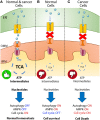Endoplasmic Reticulum-Mitochondria Calcium Communication and the Regulation of Mitochondrial Metabolism in Cancer: A Novel Potential Target
- PMID: 28944215
- PMCID: PMC5596064
- DOI: 10.3389/fonc.2017.00199
Endoplasmic Reticulum-Mitochondria Calcium Communication and the Regulation of Mitochondrial Metabolism in Cancer: A Novel Potential Target
Abstract
Cancer is characterized by an uncontrolled cell proliferation rate even under low nutrient availability, which is sustained by a metabolic reprograming now recognized as a hallmark of cancer. Warburg was the first to establish the relationship between cancer and mitochondria; however, he interpreted enhanced aerobic glycolysis as mitochondrial dysfunction. Today it is accepted that many cancer cell types need fully functional mitochondria to maintain their homeostasis. Calcium (Ca2+)-a key regulator of several cellular processes-has proven to be essential for mitochondrial metabolism. Inositol 1,4,5-trisphosphate receptor (IP3R)-mediated Ca2+ transfer from the endoplasmic reticulum to the mitochondria through the mitochondrial calcium uniporter (MCU) proves to be essential for the maintenance of mitochondrial function and cellular energy balance. Both IP3R and MCU are overexpressed in several cancer cell types, and the inhibition of the Ca2+ communication between these two organelles causes proliferation arrest, migration decrease, and cell death through mechanisms that are not fully understood. In this review, we summarize and analyze the current findings in this area, emphasizing the critical role of Ca2+ and mitochondrial metabolism in cancer and its potential as a novel therapeutic target.
Keywords: AMPK; TCA cycle; inositol triphosphate receptors; mitochondrial Ca2+ uniporter; mitochondrial transport; respiratory chain.
Figures

Similar articles
-
Metabolic adaptation to the chronic loss of Ca2+ signaling induced by KO of IP3 receptors or the mitochondrial Ca2+ uniporter.J Biol Chem. 2022 Jan;298(1):101436. doi: 10.1016/j.jbc.2021.101436. Epub 2021 Nov 19. J Biol Chem. 2022. PMID: 34801549 Free PMC article.
-
IP3R-Grp75-VDAC1-MCU calcium regulation axis antagonists protect podocytes from apoptosis and decrease proteinuria in an Adriamycin nephropathy rat model.BMC Nephrol. 2018 Jun 15;19(1):140. doi: 10.1186/s12882-018-0940-3. BMC Nephrol. 2018. PMID: 29907098 Free PMC article.
-
The ER-mitochondria Ca2+ signaling in cancer progression: Fueling the monster.Int Rev Cell Mol Biol. 2021;363:49-121. doi: 10.1016/bs.ircmb.2021.03.006. Epub 2021 Apr 12. Int Rev Cell Mol Biol. 2021. PMID: 34392932 Review.
-
Optimal microdomain crosstalk between endoplasmic reticulum and mitochondria for Ca2+ oscillations.Sci Rep. 2015 Jan 23;5:7984. doi: 10.1038/srep07984. Sci Rep. 2015. PMID: 25614067 Free PMC article.
-
Mitochondrial VDAC, the Na+/Ca2+ Exchanger, and the Ca2+ Uniporter in Ca2+ Dynamics and Signaling.Adv Exp Med Biol. 2017;981:323-347. doi: 10.1007/978-3-319-55858-5_13. Adv Exp Med Biol. 2017. PMID: 29594867 Review.
Cited by
-
3D Mitochondrial Structure in Aging Human Skeletal Muscle: Insights into MFN-2 Mediated Changes.bioRxiv [Preprint]. 2024 Jun 8:2023.11.13.566502. doi: 10.1101/2023.11.13.566502. bioRxiv. 2024. Update in: Aging Cell. 2025 Jul;24(7):e70054. doi: 10.1111/acel.70054. PMID: 38168206 Free PMC article. Updated. Preprint.
-
Lessons from the Endoplasmic Reticulum Ca2+ Transporters-A Cancer Connection.Cells. 2020 Jun 24;9(6):1536. doi: 10.3390/cells9061536. Cells. 2020. PMID: 32599788 Free PMC article. Review.
-
FR58P1a; a new uncoupler of OXPHOS that inhibits migration in triple-negative breast cancer cells via Sirt1/AMPK/β1-integrin pathway.Sci Rep. 2018 Sep 4;8(1):13190. doi: 10.1038/s41598-018-31367-9. Sci Rep. 2018. PMID: 30181620 Free PMC article.
-
Induction of Paraptosis by Cyclometalated Iridium Complex-Peptide Hybrids and CGP37157 via a Mitochondrial Ca2+ Overload Triggered by Membrane Fusion between Mitochondria and the Endoplasmic Reticulum.Biochemistry. 2022 Apr 19;61(8):639-655. doi: 10.1021/acs.biochem.2c00061. Epub 2022 Apr 1. Biochemistry. 2022. PMID: 35363482 Free PMC article.
-
Crosstalks between inflammasome and autophagy in cancer.J Hematol Oncol. 2020 Jul 23;13(1):100. doi: 10.1186/s13045-020-00936-9. J Hematol Oncol. 2020. PMID: 32703253 Free PMC article. Review.
References
-
- Margulis L. Symbiotic theory of the origin of eukaryotic organelles: criteria for proof. Symp Soc Exp Biol (1975) 29:21–38. - PubMed
-
- Nicholls DG, Ferguson SJ. Bioenergetics. 4th ed. London: Elsevier; (2013).
Publication types
Grants and funding
LinkOut - more resources
Full Text Sources
Other Literature Sources
Miscellaneous

